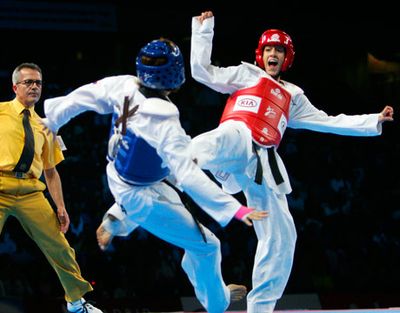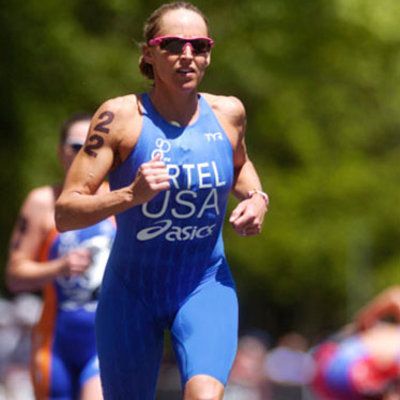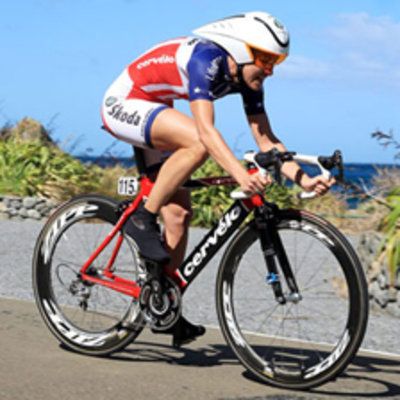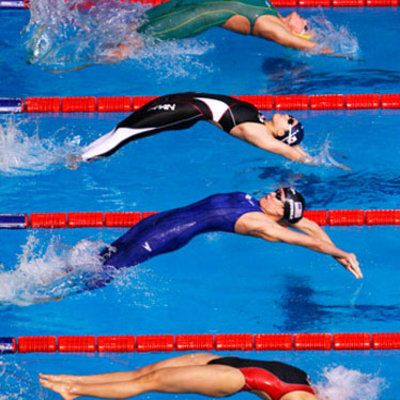5 Olympic Athletes Share Their Workout Secrets
Five Olympians share their secrets to getting fitter, faster.
Whether you want to tone up or slim down, we'll show you how with tips from these Beijing-bound athletes.
LINDSAY DAVENPORT, TENNIS
At 16, Lindsay Davenport went pro. At 20, she took home the gold at the 1996 Atlanta Summer Olympics, before going on to win the U.S. Open, Wimbledon, and the Australian Open. Now, 14 months after the birth of her son, Jagger, the former number one is eyeing the sweetest comeback of all: a repeat gold in Beijing.
RECIPE FOR SUCCESS:
Every week, Davenport, 32, does 10 to 15 hours of hitting and stroke drills at a neighborhood court in her hometown of Laguna Beach, CA, plus three hours of free weights, the occasional Pilates class ("depending on how stiff I am"), and two sessions of footwork and plyometrics (high-impact drills). The real challenge? Working around Jagger's schedule. "I try to always be home for his feedings," she says.
SECRET WEAPON:
Three-way lunges (stepping forward, laterally, then back) tone the quads and mimic the motion of hitting a low shot. Four days a week, Davenport does 10 to 20 reps on each leg.
Get exclusive access to fashion and beauty trends, hot-off-the-press celebrity news, and more.
EAT LIKE A PRO:
During her pregnancy, Davenport cut out soda and lemonade and went cold turkey on caffeine.
MIND GAME:
"Keeping your head in each point is the toughest thing about tennis," says Davenport, who spends a few moments in silent visualization before every match. "You need a sense of calm and a big sense of belief."
CHILL FACTOR:
"Being a mom has raised my confidence. The little things—bad line calls—don't bother me as much."
WORD TO THE WISE:
Davenport exercised moderately while pregnant—swimming, cardio workouts on an elliptical machine, and light weight training. "My body bounced back so much faster because of it."
Next Page: Diana Lopez, Tae Kwon Do

DIANA LOPEZ, TAE KWON DO
For Diana Lopez, 24, going to Beijing is a family affair. Her brothers Mark, 26, and two-time Olympic gold medalist Steve, 29, will also be competing; a third brother, Jean, 34, will be coaching her ringside. "It's comforting to know that I'll have people around me whom I love and trust," says Lopez, who started sparring when she was 6, occasionally with her siblings.
RECIPE FOR SUCCESS:
Beginning two months before competition, Lopez—who lives in Houston—practices tae kwon do five days a week for two hours a day. She also works in six hours of plyometrics, footwork drills, and weight training; a Bikram yoga class; and three 30-minute jogs a week.
SECRET WEAPON:
When Lopez wants fast results, she combines speed intervals with plyometrics: three sets of 10 reps of jumping on and off a raised step, with 10 seconds of uphill sprinting on a treadmill between each set. "I love the strength and explosiveness it gives me in matches."
MIND GAME:
After each practice, Lopez lies on her back while Jean leads her through a 10-minute visualization of mock fights or upcoming matches, such as her Olympic debut.
EAT LIKE A PRO:
At 5-foot-10 and 132 pounds, Lopez had to drop to 125 pounds to qualify for the featherweight division. After narrowly missing the 2004 Olympic team, she cut junk food and fast food from her diet and learned to subsist on oatmeal, fruit, lean protein, and greens. "You have to listen to your body," she says. "Now I feel so much faster in competition."
FEET UPKEEP:
Because she competes barefoot, Lopez swears by Sephora Body Scrub for keeping calluses at bay. "And I love getting pedis!"
Next Page: Julie Swail Ertel - Triathlon

JULIE SWAIL ERTEL, TRIATHLON
Working out is a full-time job when you're juggling three sports. Nobody knows this better than Julie Swail Ertel, a 35-year-old SoCal native and 2000 Olympic silver medalist in water polo who puts in 20 hours of cycling, swimming, and running a week.
SECRET WEAPON:
When Ertel incorporated a balancing exercise—standing on one leg for a minute on each side—into her DIY yoga routine a year ago, her running times dropped almost immediately. "Running is just balancing on one leg and then another," she says. Now she does the pose twice a week.
KEEPING IT FRESH:
To stave off boredom, Ertel constantly tries new things: In April, she ran a 3000-meter race at a local community college—and won.
SNEAKER SMARTS:
Running without socks is a recipe for disaster, especially when you have size 12 feet. Ertel combats blisters by plastering them with Band-Aids or coating her feet in a thin layer of Vaseline in humid climates.
WORD TO THE WISE:
Ertel suggests clipping your cycling cleats into your bike pedals at the transition zone before the race. "That way, all you have to do is slide your feet into your shoes, and you're off. It can shave 30 to 45 seconds off your time."
Next Page: Kristin Armstrong: Cycling
[image id='283b1597-0e8b-4f3a-8888-298e371588c0' mediaId='f8fe82c5-4daf-4739-a0e6-b43519aa9952' loc='C'][/image]

KRISTIN ARMSTRONG, CYCLING
Kristin Armstrong (pictured on the next page) is used to being mistaken for someone else—the ex-wife of a certain seven-time Tour de France winner. But since she started racking up her own impressive victories—including the 2006 World Time Trial Championships—Armstrong, 34, has made a name for herself as the woman to beat in Beijing. Just call her "K-Strong."
RECIPE FOR SUCCESS:
Armstrong trains in three-week blocks of increasing intensity—16 to 25 hours a week on her bike—followed by an easier recovery week. During long Idaho winters, the Boise local heads to the mountains for snowshoeing and Nordic skate-skiing.
STRENGTH ON WHEELS:
Twice a week, Armstrong uses her bike as her mobile weight room: She shifts into a high-resistance gear and does 20 to 45 minutes of low-cadence drills to work quads, glutes, and hamstrings.
SECRET WEAPON:
Armstrong sweats through two Bikram yoga classes a week. Trikonasana, or triangle pose, keeps her limber (she was diagnosed with osteoarthritis in 2001), and the room's 90-plus-degree heat helps her acclimate to humid race locales—like Beijing.
TOUGH LOVE:
During especially hard races, Armstrong talks to herself to stay focused and push through the pain. "I'll ask myself, Can you hurt any more? And then I'll say, You have to hurt harder."
WORD TO THE WISE:
Invest in a bike that fits, get a comfortable saddle (she loves her Fizik), and cycle with a group whenever possible. "Try not to be intimidated," she says. "Most important, have fun."
Next Page: Natalie Coughlin, Swimming[image id='a83c2ec0-2672-428d-b2f8-db82514200d3' mediaId='b4839a1b-5e3d-4718-a0ee-f63661b6c4c5' loc='C'][/image]

NATALIE COUGHLIN, SWIMMING
The only person who wasn't surprised when Natalie Coughlin (in blue suit, right) raked in five medals (two golds, two silvers, one bronze) at her Olympic debut in Athens was Coughlin. "I expected that of myself," says the 25-year-old Vallejo, CA, native, who started racing when she was 6.
RECIPE FOR SUCCESS:
Coughlin is in the pool by 6 a.m., six days a week, for a two-to-four-hour workout with the UC Berkeley team (she graduated in 2005). She also walks or runs with her border terrier, SheRa, and logs three hours of weight training a week.
SECRET WEAPON:
"Pilates helps improve my stroke efficiency. It also cures me of bad habits, like slouching," says Coughlin, who works out on her own or at a local studio three times a week. "You want to have the same posture in the pool as you have on land."
EAT LIKE A PRO:
Coughlin shops organic, stocks up on just-picked produce from her local CSA (community-supported agriculture), and supplements with veggies from her backyard garden. "As a swimmer, I have the potential to put on a lot of muscle, so I have to be careful."
CHILL FACTOR:
"Craniosacral therapy"—a pressure-point therapy used to treat migraines and back pain—"is so relaxing, I feel like I've been hypnotized!"
CAN'T LIVE WITHOUT:
Kinesys spray-on SPF 30. Waterproof, of course.
WORD TO THE WISE:
To streamline your stroke, look down at the bottom of the pool. "It'll take all the tension out of your shoulders. Looking ahead to the end of the lane is the biggest mistake I see people make."